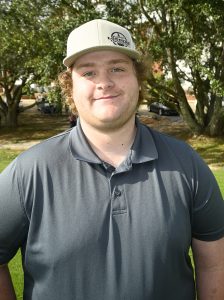ELLISVILLE – Jones College forestry and horticulture students had the unique opportunity to get a hands-on lesson using cutting edge technology called, “Ground Penetrating Radar.” Fulgham Tree Preservation Inc. owner and president, David Fulgham and board-certified master arborist, Loren Erickson introduced about 30 students to the newest version of the ground penetrating radar (GPR) system which detects roots to help determine the overall health of the tree.
 “We take the radar and map out the roots, detecting roots and their location and depth. Then, we put it on a map that we can use to create data for that tree. We can then use it to scan the trunk to look for wood density, cavities, and decay as well as hollow spots in the tree. We use it primarily for tree risk assessment,” said Fulgham.
“We take the radar and map out the roots, detecting roots and their location and depth. Then, we put it on a map that we can use to create data for that tree. We can then use it to scan the trunk to look for wood density, cavities, and decay as well as hollow spots in the tree. We use it primarily for tree risk assessment,” said Fulgham.
After the completion of construction work near some live oak trees on campus, Fulgham and Erickson were called to determine if the trees were affected. The GPR system is helping the campus landscaping crew and students preserve the beautiful, landmark live oak trees. Past methods used to assess the health of a tree were more invasive and could possibly cause more damage to the tree.
“This method has taken 20 years of development to refine so it can be used in sand and clay, and then filter the data. In this situation, a college or university may not want to buy the equipment or software, and then train someone. It’s easier to hire or collaborate with us to collect the data and develop a plan to remediate the tree,” said Fulgham.
 That’s also part of the reason why Fulgham wanted to expose the Jones College students to the GPR system. There are numerous applications for this technology in a wide variety of fields within forestry and horticulture and in other related industries. With a booming business, he needs more foresters and horticulturists.
That’s also part of the reason why Fulgham wanted to expose the Jones College students to the GPR system. There are numerous applications for this technology in a wide variety of fields within forestry and horticulture and in other related industries. With a booming business, he needs more foresters and horticulturists.
 “A lot of people think forestry is only about managing forests,” said Jones College instructor Bennett Burris. “This high-tech equipment shows students how you can manage a single tree to help preserve the trees’ natural beauty, and historical landmarks, like the Friendship Oak on the USM campus in Long Beach, as well as the live oaks on 5th Avenue in Laurel. These urban forestry settings and these trees mean a lot to people. Foresters and arborists help to preserve their health. This is another career path option.”
“A lot of people think forestry is only about managing forests,” said Jones College instructor Bennett Burris. “This high-tech equipment shows students how you can manage a single tree to help preserve the trees’ natural beauty, and historical landmarks, like the Friendship Oak on the USM campus in Long Beach, as well as the live oaks on 5th Avenue in Laurel. These urban forestry settings and these trees mean a lot to people. Foresters and arborists help to preserve their health. This is another career path option.”
In general, foresters conserve and manage our natural resources in an urban setting to the open spaces in national parks. Tupelo’s Annaleise Carroll said she plans to utilize this experience when she becomes a Park Ranger.
she plans to utilize this experience when she becomes a Park Ranger.
“National Parks don’t have a lot of staff so knowing what’s wrong with our trees, and how to treat them along with knowing the age of the trees in the national parks would be very beneficial,” explained Carroll. “I also think it’s really cool that we’ve had x-ray technology for humans and animals, along with this type of radar technology in meteorology. I’m glad to see the technology is being applied and expanded to more of nature.”
Knowledge about how GPR can be utilized is also beneficial for the horticultural students who plan on working as landscapers, like Sumrall’s Dakota Smith. He plans to take over his father’s landscaping business after finishing his bachelor’s degree at Mississippi State University.
 “As a landscaper I really appreciate learning about this new technology too. I’ve never seen anything like this, and it should help me better advise our customers on the available options we have in preserving trees,” said Smith.
“As a landscaper I really appreciate learning about this new technology too. I’ve never seen anything like this, and it should help me better advise our customers on the available options we have in preserving trees,” said Smith.
Jones College horticulture instructor, Wendy Wilkerson said understanding that the growth and health of the tree starts with a healthy root system. Knowing what effects changes in a tree’s health and how it is changing the tree, is vital in our industry.
“As landscape professionals, the students are exposed to many situations where the home or property owners would like to maintain older trees to  extend the life expectancy in the landscape and for sentimental reasons, they want to keep the trees. I’m glad our students were able to see how this system works and how to help preserve a healthy landscape overall,” said Wilkerson. “We appreciate our industry partners exposing our students to the newest technology and techniques.”
extend the life expectancy in the landscape and for sentimental reasons, they want to keep the trees. I’m glad our students were able to see how this system works and how to help preserve a healthy landscape overall,” said Wilkerson. “We appreciate our industry partners exposing our students to the newest technology and techniques.”
Without the technology, Fulgham explained they would have to air excavate the area to remove the soil without damaging the roots. However, that messy method didn’t always prove to be as beneficial.
“Previous methods, before the ground penetrating radar, could be stressful for the roots because you’re exposing them to daylight which further stresses them. Seeing the roots without ‘daylighting’ the roots help to preserve the overall health of the tree,” Fulgham explained.
JC freshman forestry student from Brookhaven, Jacob Livingston said he is confident the GPR system will be a helpful option for his future clients.
confident the GPR system will be a helpful option for his future clients.
“Technology has come a long way and it’s continually getting better. When I see trees in distress, I will now be able to offer this non-invasive option, so we won’t have to cut into the tree, further harming the tree,” said Livingston.
Damaged roots or other types of distress in trees is not always evident immediately. Erickson said it can take several years, depending on the size of the tree, before the effects of a tree’s damaged roots will be noticed. The ground penetrating radar is one way to prevent further damage and preserve the health of trees.


